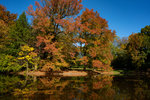The gardening experts of the Chestnut Hill Garden District Fund have a less exhausting leaf management routine to suggest, and if you do it our way, you’ll get mulch for your garden, better soil for your plants, habitat for wildlife, food for birds and you’ll put less of a burden on the city’s resources.
This item is available in full to subscribers.
We have recently launched a new and improved website. To continue reading, you will need to either log into your subscriber account, or purchase a new subscription.
If you are a digital subscriber with an active subscription, then you already have an account here. Just reset your password if you've not yet logged in to your account on this new site.
If you are a current print subscriber, you can set up a free website account by clicking here.
Otherwise, click here to view your options for subscribing.
Please log in to continue |


Is there anything more glorious than autumn leaves? On the tree, in the wind or carpeting the ground, colorful leaves add joy to every walk and drive through Northwest Philadelphia. Yet to many people, they’re also a torment—a burden to rake or drag to the curb for the city’s mechanical leaf collection trucks or to gather into leaf bags for trash collection.
The gardening experts of the Chestnut Hill Garden District Fund have a less exhausting leaf management routine to suggest, and if you do it our way, you’ll get mulch for your garden, better soil for your plants, habitat for wildlife, food for birds and you’ll put less of a burden on the city’s resources.
It begins with a change of mindset. Don’t think of leaves as litter; think of them as a resource to be preserved. A layer of slowly decomposing leaf material insulates soil, conserves moisture, reduces storm water runoff, slowly releases nutrients and improves soil structure. Leaves also provide habitat for worms and insects, supporting songbirds.
So this fall, instead of treating your leaves like trash, unleash the power of leaf mulch.
If you have a light to moderate leaf-fall on your lawn, let the leaves dry for a few days and then mow it. That’s right—as long as it’s not a thick, dense, wet layer, just mow right over the leaves (without your mower’s mulching bag). The dried leaves will be ground into fine bits and drop through to the soil. No more visible leaves, and your grass gets healthy soil.
If you have a heavy load of leaves, use the mower with the collection bag and then put the ground leaves on your garden beds and arrange them into a layer about two to three inches deep. The leaves will perform the same range of soil-enhancing services as commercial mulch, and I love the look of a carpet of leaves on my beds or around trees (but not against trunks). I add excess leaves to small compost piles tucked among the trees and shrubs on the outer margins of my property. These small compost heaps will provide rich soil for my garden and food foraging opportunities for wildlife for years to come.
Paul Meyer, former Executive Director of the Morris Arboretum, is a member of the Board of Directors for the Chestnut Hill Garden District Fund.